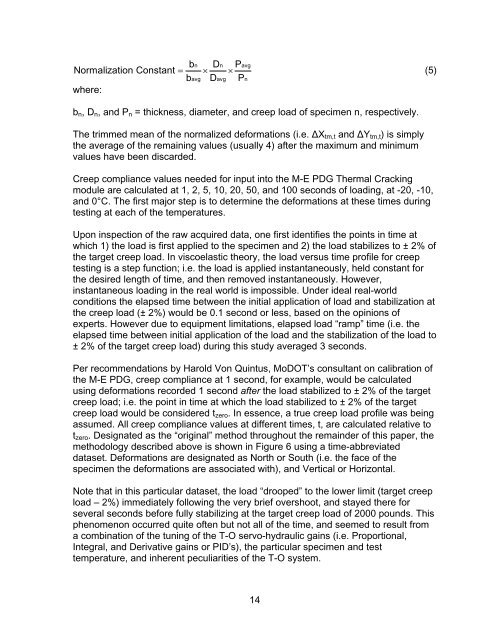Determination of Creep Compliance and Tensile Strength of Hot-Mix ...
Determination of Creep Compliance and Tensile Strength of Hot-Mix ...
Determination of Creep Compliance and Tensile Strength of Hot-Mix ...
- No tags were found...
Create successful ePaper yourself
Turn your PDF publications into a flip-book with our unique Google optimized e-Paper software.
n Dn PNormalization Constant = × × avg (5)bavg Davg Pnwhere:b n , D n , <strong>and</strong> P n = thickness, diameter, <strong>and</strong> creep load <strong>of</strong> specimen n, respectively.The trimmed mean <strong>of</strong> the normalized deformations (i.e. ΔX tm,t <strong>and</strong> ΔY tm,t ) is simplythe average <strong>of</strong> the remaining values (usually 4) after the maximum <strong>and</strong> minimumvalues have been discarded.<strong>Creep</strong> compliance values needed for input into the M-E PDG Thermal Crackingmodule are calculated at 1, 2, 5, 10, 20, 50, <strong>and</strong> 100 seconds <strong>of</strong> loading, at -20, -10,<strong>and</strong> 0°C. The first major step is to determine the deformations at these times duringtesting at each <strong>of</strong> the temperatures.Upon inspection <strong>of</strong> the raw acquired data, one first identifies the points in time atwhich 1) the load is first applied to the specimen <strong>and</strong> 2) the load stabilizes to ± 2% <strong>of</strong>the target creep load. In viscoelastic theory, the load versus time pr<strong>of</strong>ile for creeptesting is a step function; i.e. the load is applied instantaneously, held constant forthe desired length <strong>of</strong> time, <strong>and</strong> then removed instantaneously. However,instantaneous loading in the real world is impossible. Under ideal real-worldconditions the elapsed time between the initial application <strong>of</strong> load <strong>and</strong> stabilization atthe creep load (± 2%) would be 0.1 second or less, based on the opinions <strong>of</strong>experts. However due to equipment limitations, elapsed load “ramp” time (i.e. theelapsed time between initial application <strong>of</strong> the load <strong>and</strong> the stabilization <strong>of</strong> the load to± 2% <strong>of</strong> the target creep load) during this study averaged 3 seconds.Per recommendations by Harold Von Quintus, MoDOT’s consultant on calibration <strong>of</strong>the M-E PDG, creep compliance at 1 second, for example, would be calculatedusing deformations recorded 1 second after the load stabilized to ± 2% <strong>of</strong> the targetcreep load; i.e. the point in time at which the load stabilized to ± 2% <strong>of</strong> the targetcreep load would be considered t zero . In essence, a true creep load pr<strong>of</strong>ile was beingassumed. All creep compliance values at different times, t, are calculated relative tot zero . Designated as the “original” method throughout the remainder <strong>of</strong> this paper, themethodology described above is shown in Figure 6 using a time-abbreviateddataset. Deformations are designated as North or South (i.e. the face <strong>of</strong> thespecimen the deformations are associated with), <strong>and</strong> Vertical or Horizontal.Note that in this particular dataset, the load “drooped” to the lower limit (target creepload – 2%) immediately following the very brief overshoot, <strong>and</strong> stayed there forseveral seconds before fully stabilizing at the target creep load <strong>of</strong> 2000 pounds. Thisphenomenon occurred quite <strong>of</strong>ten but not all <strong>of</strong> the time, <strong>and</strong> seemed to result froma combination <strong>of</strong> the tuning <strong>of</strong> the T-O servo-hydraulic gains (i.e. Proportional,Integral, <strong>and</strong> Derivative gains or PID’s), the particular specimen <strong>and</strong> testtemperature, <strong>and</strong> inherent peculiarities <strong>of</strong> the T-O system.14
















